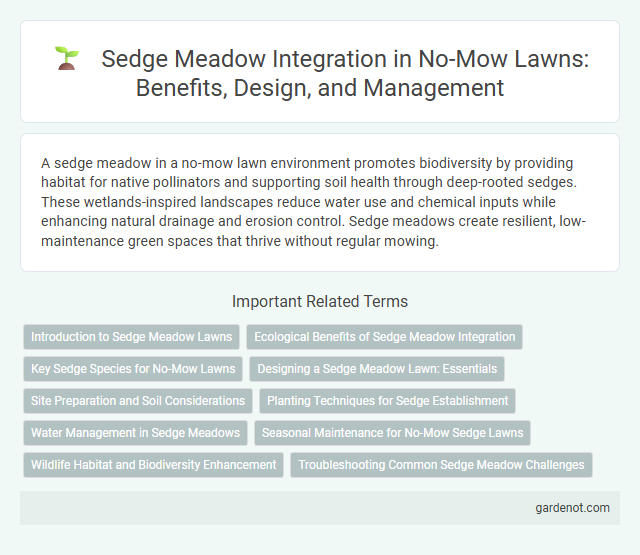A sedge meadow in a no-mow lawn environment promotes biodiversity by providing habitat for native pollinators and supporting soil health through deep-rooted sedges. These wetlands-inspired landscapes reduce water use and chemical inputs while enhancing natural drainage and erosion control. Sedge meadows create resilient, low-maintenance green spaces that thrive without regular mowing.
Introduction to Sedge Meadow Lawns
Sedge meadow lawns are low-maintenance, eco-friendly landscapes composed primarily of sedge species like Carex, which thrive in moist, well-drained soils. These lawns provide excellent erosion control, support native wildlife, and reduce the need for mowing, fertilizing, and irrigation compared to traditional grass lawns. By incorporating sedge plants, property owners create sustainable, wildlife-friendly environments that enhance biodiversity and improve soil health.
Ecological Benefits of Sedge Meadow Integration
Sedge meadows enhance biodiversity by providing critical habitat for native pollinators, amphibians, and waterfowl, promoting a balanced ecosystem within no-mow lawns. Their dense root systems improve soil health and water filtration, reducing erosion and nutrient runoff. Integrating sedge meadows supports natural pest control and carbon sequestration, contributing to sustainable landscape management.
Key Sedge Species for No-Mow Lawns
Key sedge species for no-mow lawns thrive in sedge meadows, providing low-maintenance ground cover with high ecological value. Carex pensylvanica, Carex crinita, and Carex vulpinoidea are prominent species that support biodiversity by offering habitat for pollinators and contributing to soil stabilization. These sedges require minimal mowing, enhance water retention, and promote a sustainable, natural lawn alternative.
Designing a Sedge Meadow Lawn: Essentials
Designing a sedge meadow lawn requires selecting native sedge species such as Carex stricta and Carex stipata for effective water filtration and erosion control. Incorporating diverse sedge varieties ensures year-round texture and habitat value, while considering soil moisture gradients enhances plant health and sustainability. Proper site assessment and hydrology management optimize the sedge meadow's ecological function and aesthetic appeal in no-mow lawn designs.
Site Preparation and Soil Considerations
Sedge meadows thrive in moist, poorly-drained soils rich in organic matter, making soil assessment crucial before establishment. Effective site preparation involves removing existing turf and managing soil compaction to promote healthy root development. Maintaining appropriate soil moisture levels supports sedge growth, enhancing the no-mow lawn's ecological benefits and resilience.
Planting Techniques for Sedge Establishment
Planting techniques for sedge establishment in no-mow lawns emphasize soil preparation by loosening the ground to enhance root penetration and water retention. Using container-grown or bare-root sedge plugs spaced 6-12 inches apart promotes dense coverage and reduces weed encroachment. Incorporating organic mulch around young sedge plants helps maintain soil moisture and temperature, crucial for successful establishment in sedge meadows.
Water Management in Sedge Meadows
Sedge meadows play a crucial role in water management by naturally filtering stormwater and reducing runoff through their dense root systems. These wetlands improve groundwater recharge and maintain water quality by trapping sediments and absorbing nutrients. Implementing sedge meadows in no-mow lawn designs enhances sustainable water management while supporting local biodiversity.
Seasonal Maintenance for No-Mow Sedge Lawns
Sedge meadows in no-mow lawns require seasonal maintenance such as early spring cutting to remove winter debris and light thinning to prevent overcrowding. Removing dead material in late fall improves airflow and reduces pest habitats while minimal watering supports natural growth cycles. Timely spot weeding preserves the sedge's dominance, ensuring a healthy, low-maintenance lawn ecosystem year-round.
Wildlife Habitat and Biodiversity Enhancement
Sedge meadows provide critical wildlife habitat by supporting diverse insect populations, amphibians, and bird species that rely on moist, nutrient-rich environments. These no-mow areas improve biodiversity by creating a complex plant community structure, fostering pollinator activity and offering shelter for small mammals. Maintaining sedge meadows as no-mow zones promotes ecological balance and resilience in urban and suburban landscapes.
Troubleshooting Common Sedge Meadow Challenges
Sedge meadows often face challenges such as poor drainage, invasive weed encroachment, and uneven plant growth, which can be mitigated by improving soil moisture management and regularly monitoring for invasive species like nutsedge and yellow nutsedge. Addressing these issues includes enhancing water flow through grading or installing drainage systems, applying selective herbicides carefully to avoid damaging sedges, and promoting native sedge vigor through proper mowing intervals. Effective troubleshooting ensures a healthy, low-maintenance no-mow lawn that supports biodiversity and reduces maintenance efforts.
Sedge meadow Infographic

 gardenot.com
gardenot.com